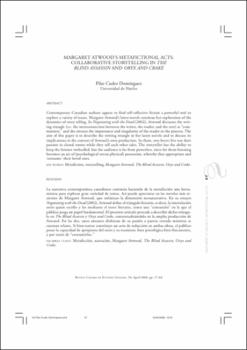Margaret Atwood's Metafictional Acts: Collaborative Storytelling in The Blind Assassin and Oryx and Crake
Autor
Cuder Domínguez, PilarFecha
2008Resumen
La narrativa contemporánea canadiense continúa haciendo de la metaficción una herramienta para explorar gran variedad de temas. Así puede apreciarse en las novelas más recientes de Margaret Atwood, que enfatizan la dimensión metanarrativa. En su ensayo Negotiating with the Dead (2002), Atwood define el triángulo literario, es decir, la interrelación entre quien escribe y lee mediante el texto literario, como una “comunión” en la que el público juega un papel fundamental. El presente artículo procede a describir dicho triángulo en The Blind Assassin y Oryx and Crake, contextualizándolo en la amplia producción de
Atwood. En las dos, unos amantes disfrutan de su pasión a puerta cerrada mientras se cuentan relatos. Si bien narrar constituye un acto de seducción en ambas obras, el público posee la capacidad de apropiarse del texto y su trasmisor, bien psicológica bien físicamente, y por tanto de “consumirlos.” Contemporary Canadian authors appear to find self-reflective fiction a powerful tool to
explore a variety of issues. Margaret Atwood’s latest novels continue her exploration of the
dynamics of story telling. In Negotiating with the Dead (2002), Atwood discusses the writing triangle (i.e. the interconnection between the writer, the reader, and the text) as “communion,” and she stresses the importance and singularity of the reader in the process. The
aim of this paper is to describe the writing triangle in her latest novels and to discuss its
implications in the context of Atwood’s own production. In them, two lovers live out their
passion in closed rooms while they tell each other tales. The storyteller has the ability to
keep the listener enthralled, but the audience is far from powerless, since for them listening
becomes an act of (psychological versus physical) possession, whereby they appropriate and
‘consume’ their loved ones.





